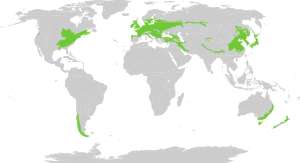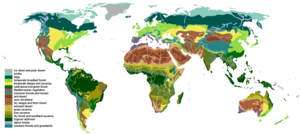AY Honors/Temperate Deciduous Forests/Answer Key
1. Describe or explain the following information about temperate deciduous forests:
a. In simple terms, describe a temperate deciduous forest.
A moist forest composed of broad-leafed trees, which lose their leaves in the winter.
b. List several characteristics of temperate deciduous forests.
The climate has distinct warm and cool seasons - one of them may be rather dry.
There is a seasonal appearance and disappearance of the canopy. The canopy is the leaves on the trees. These leaves die each autumn and in the spring, appear as new growth.
Flowering species time their flowering for the spring just prior to the canopy's appearance, when light still makes it to the forest floor.
Migratory birds often time their arrival for shortly after the canopy opens so as the have access to the (now present) insects and the protective cover of the canopy. [1]
c. Provide other names that are used for the temperate deciduous forest.
“Temperate Broadleaf Forest” or “Mixed Forest”
d. From a map, show the continents where temperate deciduous forests can be found.
North America, Europe, Asia, Australia. Note forests are not found in all parts of these continents, but they occur in locations that have suitable climates in these 4 continents.
e. Define biome. What is usually found north of the temperate deciduous forest?
A Biome is a group of plants and animals that are adapted to meet the natural regional environment’s physical environment, latitude, elevation, and terrain. Taiga (coniferous forest) – the winters are too cold here for deciduous trees to grow.
Please view the linked "biomes of the world" image to see how some scientists divide the worlds biomes.
2. Identify, from pictures or in nature, four types of trees commonly found in temperate deciduous forests.
3. Explain why leaves turn color in the fall.
4. Read Genesis 1:11-13. Discover when Genesis 1 says the trees were created.
5. Identify, from pictures or in nature, at least five species of flowering plants commonly found in a temperate deciduous forest. Why are they usually only found in spring?
6. Identify, from pictures or in nature, at least five species of mammals commonly found in the temperate deciduous forests.
7. Identify, from pictures or in nature, at least five types of birds commonly found in temperate deciduous forests.
8. List important resources provided to your region by temperate deciduous forests.
9. Learn about one invasive species that affects temperate deciduous forests.
Invasive (non native) species abound. Plants, animals, and birds can all be considered invasive (non native) if they were introduced into an area that they were not originally native to.
National Park Service (USA) has a complete site with hundreds of links dedicated to invasive species present in the National Park system [2].
Plants:
Key Online resources:
- Invasive Plant Atlas.org [3] [National Park Service http://www.nps.gov] (search park name and then invasive species for a list)
- The National Park Service (USA) has also provided downloadable PDFs with details and pictures for hundreds of invasive plant species by region.
Mid-Atlantic [4]
In the United States, the story usually goes something like this: Originally brought from (China, Japan, India, etc.) as an ornamental or decorative plant. Escaped, and began to take over the area.
Other plants were brought over purposefully to aid in erosion control, plant control, or even insect control. However, the invasion of the new species usually far outweighed the benefits.
Some invasive plant species include:
Kudzu Vine (widespread across the mid-atlantic and southern USA)
11. Do at least three of the following activities:
a. Visit an exhibit or conservatory of deciduous tree species.
b. Make a collection of at least five types of leaves from temperate deciduous forest trees.
c. Visit a zoo or nature center where there are animals typical of the temperate deciduous forests biome.
Adventist Youth Honors Answer Book/Zoo Visit



